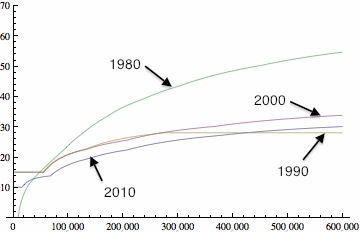IndependentlyPoor
Thinks s/he gets paid by the post
I was bored, so I decided to plot out the effective income tax rates for several years. Been wanting to do this for a long time. All dollars in constant 2010 dollars.

Whether one is in favor of it or not, tax rates have certainly become less progressive. As Ziggy has pointed out, this does not capture the effect of closing loopholes that came with the Reagan reductions.
If I get motivated, I might add a few more years in the 50s, 60s, and 70s.
Tax data from:
http://www.taxfoundation.org/files/fed_individual_rate_history-june2010.xls
CPI data from
http://www.econ.yale.edu/~shiller/data/ie_data.xls

Whether one is in favor of it or not, tax rates have certainly become less progressive. As Ziggy has pointed out, this does not capture the effect of closing loopholes that came with the Reagan reductions.
If I get motivated, I might add a few more years in the 50s, 60s, and 70s.
Tax data from:
http://www.taxfoundation.org/files/fed_individual_rate_history-june2010.xls
CPI data from
http://www.econ.yale.edu/~shiller/data/ie_data.xls

